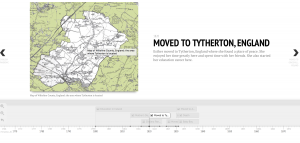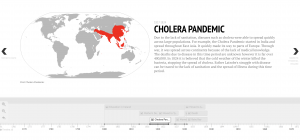Overall, I was happy with how our final digital artifact, our wordpress website, turned out. It was a nice way to display everything we have created and learned this year about Esther Latrobe, her journey/life, and the different digital tools and artifacts we used. After some deliberation, we chose a simple and clean theme that didn’t have too many spaces for pictures. We wanted the focus to be on the text and on Esther. It was hard to choose a theme because many of them were picture oriented. But, we decided a great picture to display on the homepage would be the first excerpt from Esther Latrobe’s actual memoir. It includes her full name and the cursive handwriting looks elegant. We wanted this to be the first thing users saw because that’s where it all began for us.
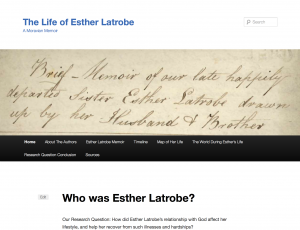
We played around with the website for a bit and tried to see how everything worked. We included a page with the summary of her life and research question, an About the Authors page, a copy of her memoir, the transcription desk, voyant, TEI tagging, the digital edition, the timeline, the story map, contextual events, our research question conclusion, and our sources page. We used a couple of drop down menus along the toolbar so it wouldn’t appear too cluttered for users.
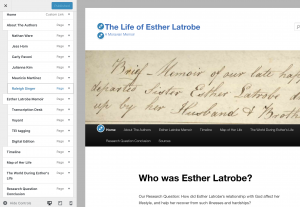
We included a summary so people could get some background information on Esther’s life and we added our research question and conclusions so users would understand what our focus was throughout the semester. We wanted to include a clean copy of her memoir so people could see the actual memoir. It is so cool to see the original document, even if it is in picture form, because users can see what we were working with and see how people wrote back then. The beautiful cursive is very different than how we handwrite things today. We also included pages devoted to the transcription desk, voyant, and TEI tagging so everyone would understand the process it took to properly transcribe and extract information from this text. I think one of the most important pieces was the digital edition, which is “ a derivative document that holds a relationship with the transcribed document, and [a digital edition is] a formal (public) presentation of such a derivative document.” (Pierazzo 2). It was so cool that we created the first digital edition of this memoir ever. It is easily accessible now; you don’t need to travel and dig through an old archive, you can just hop on the internet at your convenience. The timeline was one of our biggest projects so it was important that it be included as well. We were able to see her life as an organized series of events. It was helpful and easier to analyze her life this way. I also thought the map was very important too, because you could really visualize her life and see how far she traveled. When looking at the map we were able to find background information on every place she lived. For example, I used https://history.wiltshire.gov.uk/community/getchurch.php and www.gracehillvillage.org to find out information on Tytherton and Gracehill respectively, two places with Moravian origins, and two of the places Esther lived. Finally, we decided to have a page called The World During Esther’s Life. We felt it was important to include context and explain what was going on in this time period. We can look at the big picture and see how world events impacted one life. We embedded certain things like the story map and the timeline, and we included screenshots of other tools we used.
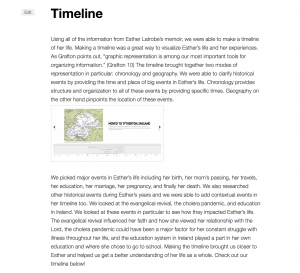
We assigned each other different roles for the website and one of my main responsibilities for this site was creating her timeline page. I chose her timeline because, “graphic representation is among our most important tools for organizing information.” (Grafton 10). I wrote about the process of creating her timeline, the events we decided to include, and how it gave us a better look at Esther’s life. I added a screenshot and embedded the actual timeline so users can scroll through our actual work. In addition, we ran into some challenges with simply formatting and navigating the wordpress site. For example, it took us a little bit of time to actually create the drop down menus. Luckily, one of our group members had experience with this program and helped us figure it out. Our research question was, How did Esther Latrobe’s relationship with God affect her lifestyle, and help her recover from such illnesses and hardships? We came up with this question after carefully reading her forty page memoir. We noticed that Esther was very devoted to her religion and she unfortunately spent most of her short life ill. So, we decided to put those two aspects together and analyze her life with this in mind. I believe that the digital tools we used throughout the semester helped us answer this question. Every tool we used aided us in examining her memoir in different ways and we really got an inside look at what her life was like. I thought it was helpful having the snap talk because it was basically all of the information from our website in a google slides presentation. I thought that our group worked very well together throughout the whole semester. We worked as a cohesive unit and got all of our work done. It was a fascinating experience working in a group for basically the whole semester, luckily we didn’t have too many problems if at all. Everyone was open minded and it was useful having five other people I knew I could rely on in the class. Every assignment and digital tool we used brought us closer to understanding Esther Latrobe’s life.
http://latrobehumn100.blogs.bucknell.edu
Jessica Hom is currently a sophomore at Bucknell University. At Bucknell, she plays on the varsity softball team and is currently undeclared. She is from Syosset, NY and is a graduate from Syosset High School.


